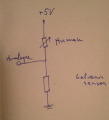- introduction to tools at the DIY Biolab
Sensor
the most simple self-made sensor
Student works
Other artworks
Miya Masaoka, Pieces for Plants
http://www.youtube.com/watch?v=1AHOEcAprc8
Masaoka uses electronic interfaces attached to the plants to generate sound (as well as text, appearing in a video performance). While changing her body position in relation to the plants (approaching, touching, retreating), Masaoka changes the physical properties of the space, which, in turn, affects the plants. Plants sense the changing environment and further transport the captured changes in the form of electrical signals to the electrodes attached to them. The electrical signals captured are then translated into digital signals and transferred into the computer for further manipulation.
Martin Howse, Radio Mycelium
http://libarynth.org/parn/radio_mycelium
Howse examines connectivity and interaction between the physical properties of the environment and mycelium networks from a scientific, cultural and technical perspectives. "The Radio Mycelium workshop aims to actively examine the cross-spore-germination between two parallel wide area networks; between radio-based communication technologies and the single organism network of the mycelium." (Martin Howse)
Laura Popplow, Fungutopia
As a very complex project, Fungutopia becomes a platform to discuss a variety of topics related to fungi. Along with the reference topics covered by Paul Stamets, Fungutopia is also about cooking, DIY electronics, open-source initiatives, sustainability, social practices and, of course, contemporary aesthetics.



